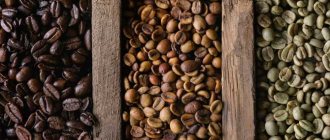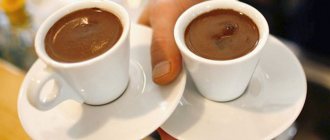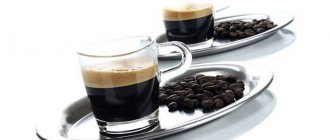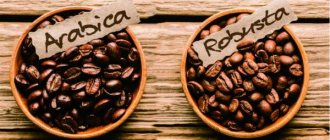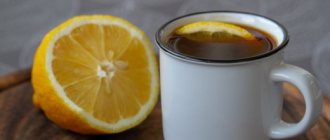Coffee con panna is a type of regular or double espresso with whipped cream on top. Italy is considered the birthplace of the drink, in translation from whose language con-panna is called “coffee with cream.”
Many people mistakenly confuse the cocktail with Viennese coffee, but this is not entirely correct. The thing is that the Viennese version also uses cream, but the coffee drink there is completely different. It is prepared in Turk. For con panna, only espresso is used. In addition, in Austria the Viennese recipe is seasoned with whipped milk.
Difference between Viennese coffee and con panna
Translated from Italian, con panna means “with cream”). In order to whip cream to stiff peaks without having a mixer at hand, you need to work hard. Therefore, in the 17th–18th centuries, only wealthy Italians could afford coffee con panna.
With the invention in the 20th century of coffee machines and electrical devices that made it possible to quickly whip cream into a stiff foam, con panna became much easier to prepare, and it appeared on the menu of even the most inexpensive establishments. But if in earlier times it did not matter how the coffee base was brewed, then from the mid-20th century to the present day the drink is made only with espresso. Even the term “espresso con panna” appeared.
Espresso con panna is easy to distinguish from Viennese coffee:
- Viennese coffee is usually prepared using black coffee brewed in any way. Real con panna is made exclusively with espresso;
- Viennese coffee cream is whipped to a smooth, elastic foam that you can drink while simultaneously tasting the coffee bitterness and delicate creamy sweetness in your mouth. Coffee con panna is decorated with a head of cream, whipped into stiff foam until it reaches stable peaks. Con panna should not be drunk with foam: it must first be eaten with a spoon and then washed down with coffee.
- The Austrians call con panna Franciscaner. The fact is that Capuchins are a common nickname for monks from the Franciscan order. According to the logic of the Austrians, if Italian coffee with milk is cappuccino, then a more aristocratic drink with cream is Franciscan.
How to garnish espresso con panna
To make the traditional recipe look more festive and interesting, you can decorate it with chocolate shavings. You can, of course, grate the chocolate using a regular grater and sprinkle whipped cream on top. Or you can do what professional baristas do.
They first freeze the chocolate in the freezer, after which they break off fairly large flakes with a special ice pick. The shavings turn out beautiful, shaped, and you can feel its aftertaste well. And what about the sound of chocolate crunching when you enjoy such an incredibly beautiful and bright dessert?!
Experts say that you should not add alcoholic beverages, syrups and other fillers to such coffee, since the delicate and aromatic drink will be spoiled by any extraneous ingredients. Although sometimes you can find recipes in which cinnamon is used instead of chocolate. The whipped cream is also sometimes sprinkled with crushed nuts.
But here you need to be very careful - the taste of the nut can completely cover the aromatic composition of the coffee, and a low-quality nut will forever spoil the impression of the prepared drink. It is better to stick to the classic recipe, thanks to which both you and your guests will maximize all the advantages of this magnificent drink.
Con panna is served in thick-walled ceramic cups - demitasse, or transparent glasses. The guest must be offered a spoon. If the coffee is not sweetened in advance, you can serve a sugar bowl or a stick of sugar.
The drink is by no means a diet drink, so those who are watching their figure will have to give up a dish of equal calorie content or even dinner after con panna.
Ingredients for making con panna
100% Arabica beans are best for making con panna. However, there is no need for expensive single-origin varieties, since cream will still hide the subtle notes of coffee flavor. Indian Arabica, which has chocolate notes, goes well with cream.
Robusta is often included in espresso blends: it produces a stable foam. Fans of strong coffee are not forbidden to prepare the base for con panna from blends containing up to 20% robusta. But its bitterness stands out too clearly against the background of sweet cream.
Cream will simply “overwhelm” the taste of light roasted coffee. The Viennese roast is ideal for con panna. The combination of cream with darker roasted coffee is not for everyone. The beans are ground to a fine espresso grind or slightly coarser (but finer than average).
Water should be moderately soft, non-chlorinated. Bottled water with mineralization from 75 to 250 mg/l is suitable.
For coffee con panna, it is better to use natural cream with a fat content of 33–35% (with a lower fat content, it will not whip into a stiff foam). If you have a choice, it is advisable to take thinner cream rather than thick cream like sour cream. Sometimes, to save time, coffee is decorated with vegetable cream from a container, but their taste is worse than natural ones.
Coffee recipe
If you look at the ingredients, con panna is:
- 25-50 ml espresso;
- sugar to taste - for coffee;
- 1 tsp powdered sugar or sugar for cream;
- 20 ml. cream with a fat content of 35%;
- cinnamon - to taste.
For this drink, it is very important to whip the cream correctly. Since they turn into stiff peaks before the sugar has time to melt, it is often customary to use powdered sugar. You need to start whipping the cream with low mixer speeds, gradually increasing them. A blender will not work in this case, since its speed is always static. The powder should be added little by little at the end of churning.
Required Ingredients
The most suitable type of coffee for this drink is medium roast Arabica, without any flavor impurities. It is not advisable to choose expensive varieties with flavor nuances - cream will still kill the zest of elite bean options. For variety, Indian Arabica is also suitable - it has notes of chocolate that harmoniously combine with creamy foam.
Those who like stronger coffee will like Robusta beans. With it the foam will be more stable. However, the bitter shade of this variety will be noticeable against the background of delicate cream.
A special moment is roasting the beans. You should not choose a light roast, as cream will overwhelm the taste of this option. For con panna, the Viennese roast is ideal. The grains must be ground finely.
It is necessary to choose purified water as a basis - it has neither its own taste nor smell. It should be non-chlorinated, moderately soft. Mineralization is allowed in the range from 75 to 250 mg/l. This water will allow the drink to become original, without additional impurities.
For you:
Coffee recipes with eggs
The final feature of this sweet is cream. You cannot save on them by purchasing products with a low fat content. The cream should be at least 35% fat, otherwise it will not whip. In addition, the sweet taste that makes con panna special is lost. Of course, if you don’t want to whip stiff peaks yourself, you can use cream from an airtight container. With its help, making a coffee cap is faster and easier.
Cooking technology
Step-by-step instructions will allow you to prepare a flavorful drink quickly and easily:
- Whip the cream with 5 g of sugar. The whipping time depends on the fat content of the product. The result should be stable peaks.
- We heat a ceramic cup of a coffee maker or a ceramic Turk with steam.
- We prepare espresso according to the classic recipe - use 7 g of coffee per 30 ml of water. You can use a double shot of espresso.
- Decorate the brewed drink with a slide of cream.
To finish, con panna can be sprinkled with cinnamon.
Characteristics of con panna
| Bean varieties | A blend of several varieties of Arabica, but for lovers of strong coffee - a mixture containing up to 20% robusta |
| Roasting degree | Medium (Full City or Viennese) |
| Grinding | Fine or medium espresso |
| Coffee machine pressure | In the espresso chamber - at least 9 bar, pump operating pressure - at least 15 bar |
| Group water temperature | From +91 to +93 °C |
| Ready coffee temperature | In a cup - +67 ± 3 °C |
| Cooking time | 7–10 minutes |
| Portion output volume, ml | 50–70 ml |
| Caffeine content (strength) | 50–116 mg (per serving) |
| Recommended intake (servings per day) | 1 |
| Maximum permissible norm (servings per day) | 2 |
| Calorie content | With sugar in cream, without it in coffee – 88.60–90.85 kcal per serving; with sugar in coffee and cream – 107.95–110.2 kcal |
Treats for guests
The first question that appears when guests suddenly arrive is “what should I treat them with?” The Italian, without hesitation, will answer that Con Panna will be an impeccable treat because it is:
Well, in order to make the treat more festive and slightly vary the taste properties, you can decorate the mound of cream with grated dark (bitter) chocolate and add chopped nuts. By the way, some baristas do not grate chocolate, but having previously frozen it in the refrigerator, use an ice pick to turn it into large crumbs and fragments. This not only looks more original, but also creates the sound effect of chocolate crunching.
Adding alcohol or syrups is strictly contraindicated, since it will no longer be Kon Panna, and the delicate taste of the drink will be irrevocably spoiled. Return to content
Espresso con panna: recipe.
Many experts say that this type of coffee as con panna was known for a long time before cappuccino or latte, but it is most likely impossible to find out for certain the history of the origin of this drink. Although some scientists say that espresso con panna is nothing more than Viennese coffee.
Con panna recipe
The coffee base can be either one or two servings of espresso. A drink with one shot is usually called “solo con panna” on the menu, while a drink with two is called “doppio con panna”.
The cream whips faster than the sugar can melt, so powder is added to it. To avoid getting butter, start beating at low mixer speeds and then increase them. A blender is not suitable for whipping, as due to the high speed the cream separates and butter is formed. The powder begins to be sprinkled in a thin stream at the end of whipping.
At home, if there is no carob coffee maker, espresso is sometimes replaced with black coffee prepared in a Turk or in a geyser coffee maker. This drink is also tasty, but it is no longer a classic con panna, but just coffee with cream.
Ingredients:
- 25–50 ml espresso;
- 20 ml cream with a fat content of 33–35%;
- 1 tsp. powdered sugar for cream;
- sugar for coffee - to taste;
- grated chocolate, nuts, cinnamon, chopped orange zest - to taste.
Cooking technology
- Whip cream with 5 g sugar.
- Warm up the ceramic cup with steam.
- Brew espresso.
- Place a mound of cream on top of the coffee.
- Decorate the cream with chocolate chips, cinnamon, nuts, and orange zest (to taste).
Traditional recipe
According to legend, when the Turks fled Europe after an unsuccessful battle, they abandoned bags of coffee beans. Local residents did not understand the taste of the black, bitter liquid, and then one of the blacksmiths began to combine coffee with other ingredients. Sugar added contrast and hid the pronounced bitterness, while cream added tenderness. It was this option that the Italians loved, and now it is considered a classic.
To turn one shot of ordinary espresso into the desired Con Panna, you will need:
- a standard serving of fresh espresso is about 50 ml;
- sugar to taste;
- 30 ml heavy cream;
- a teaspoon of powdered sugar for whipping (granulated sugar can be used, but is not advisable);
- optional - cinnamon.
The base can be either standard or double espresso. Depending on the concentration of the base, the finished drink will be called “Solo Con Panna” or “Doppio Con Panna”.
Have you tried Con Panna espresso?
Yes
No
Preparing Italian coffee “Con Panna”
The classic drink recipe consists of espresso (single, medium or even double) and whipped cream.
To prepare excellent quality espresso, experts advise paying attention to the coffee mixture. An important role in this is played by the ratio of Arabica and Robusta varieties. The degree of roasting of the beans also affects the quality of the finished drink, both its taste and its aroma. In Italian coffee shops, the formula of the mixture is kept in the strictest confidence and is considered a trade secret. This is not surprising, because, firstly, it is the author’s, and secondly, it determines 99% of the taste characteristics of coffee.
By the way, the classic Italian recipe involves the use of natural cream, whipped in a mixer or using a blender. But the eternal rush and lack of time also influenced the recipe for Con Panna espresso, and today even in Italian coffee shops they use cream from cans instead of natural cream.
Another relaxation that changed both the recipe and the taste of the drink was its base. If the canonical recipe assumes as a base ONLY espresso brewed in a carob-type coffee maker, then modern variations allow the base to be prepared using a French press. Although, Italians categorically do not recognize such a drink as their “Con Panna” espresso.
Return to content
A modern version of Con Panna
In the modern interpretation, Con Panna means coffee with cream, which is why this version differs from Viennese coffee. In the first case, the traditional recipe uses cream, and in the 2nd case, milk. Con panna is an indispensable component of espresso. With all this, they can use not even ordinary espresso, but doppio - a drink of double strength. Never use instant coffee for such a drink, because the taste and smell of the coffee will be completely different.
The second essential ingredient is cream. It should only be natural cream, whipped until fluffy. Milk, even the richest milk, is not suitable for these purposes, and again it’s all about the end result. The milk will quickly settle and will not give that rich and tender taste like cream.
For con panna, serving with special devices is also inevitable. For this wonderful drink, a special porcelain cup with rather thick walls is used. This cup is called demitas. The choice for such a cup fell for a reason. Thick porcelain walls make it possible to keep the drink warm for a very long time. And, as is clear, when cooled, espresso loses not only its aromatic and taste characteristics, but also a huge part of the necessary substances.
From time to time in restaurants and coffee shops you can see espresso con panna, which is served in glass cups. This approach is not entirely correct in terms of presentation technology, but based on the visual effect, it all looks very good. The transparent walls of the cup allow you to fully enjoy the beautiful combination of white whipped cream and dark espresso.
